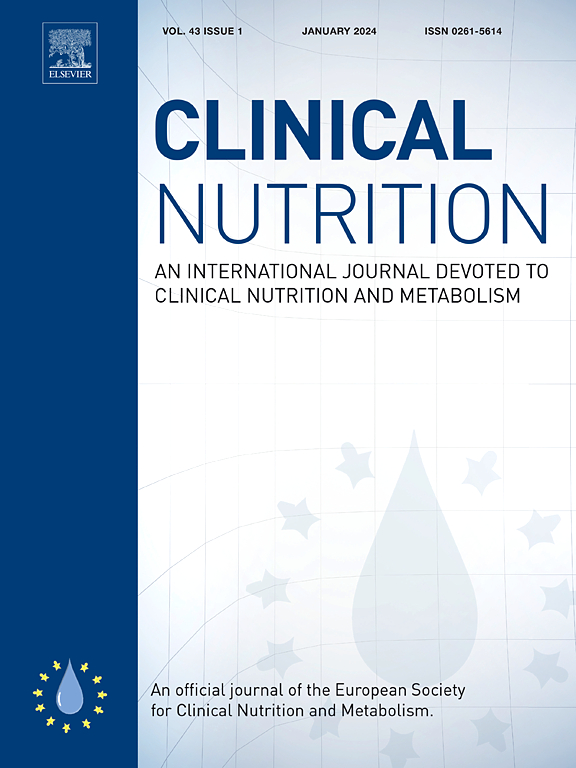Nutritional frailty and the incidence of depression and anxiety among middle-aged and older adults: A prospective cohort study
IF 6.6
2区 医学
Q1 NUTRITION & DIETETICS
引用次数: 0
Abstract
Background & aims
Frailty has been linked to an increased risk of mental disorders. However, little is known about the impact of nutritional frailty, a crucial phenotype of frailty, on depression and anxiety. We aimed to examine the prospective associations between nutritional frailty and the incidence and progression of depression and anxiety among middle-aged and older adults.
Methods
Data were obtained from a large prospective cohort study with over 500,000 participants. Nutritional frailty was defined as the copresence of physical frailty (assessed by weight loss, exhaustion, low physical activity level, slowness, and weakness) and nutritional imbalance (assessed by body mass index, skeletal muscle index, and sodium, potassium, and iron intake). Depression, anxiety, and their comorbidity were identified via the International Statistical Classification of Diseases and Related Health Problems, Ninth Revision and Tenth Revision, on the basis of the primary or secondary diagnosis. We performed Cox proportional hazards models to investigate the associations between nutritional frailty and incident depression, anxiety, and their comorbidity. Multistate models were used to examine how nutritional frailty influences transitions from a baseline state to single mental disorders, their comorbidity, and mortality.
Results
We included 176,987 participants with a mean age of 56.1 years (SD 8.0), of whom 2648 (1.5%) had nutritional frailty at baseline. During a median follow-up of 12.2 years, 4794 (2.7%) developed depression, 6081 (3.4%) developed anxiety, and 1610 (0.9%) developed both conditions. Individuals with nutritional frailty had a significantly greater risk of developing depression, anxiety, and their comorbidity than robust individuals and those with physical frailty and nutritional imbalance (depression: nutritional frailty HR 3.21 [95% CI 2.77–3.73]; physical frailty 3.11 [2.70–3.58]; nutritional imbalance 1.19 [1.11–1.28]; anxiety: 2.25 [1.93–2.63], 2.17 [1.87–2.51], 1.20 [1.13–1.28]; comorbidity: 3.69 [2.92–4.66], 3.43 [2.74–4.28], 1.31 [1.15–1.50]), even after multivariable adjustment. Baseline nutritional frailty adversely impacts transitions from a baseline state to single mental disorders (depression: 2.89 [2.49–3.36], anxiety: 1.82 [1.54–2.16]) and death (1.95 [1.71–2.22]), from single mental disorders to their comorbidity (depression: 1.96 [1.32–2.89]; anxiety 1.78 [1.17–2.71]), and from comorbidity to death (2.04 [1.07–3.91]).
Conclusions
Nutritional frailty is an independent risk factor for incident depression, anxiety, and their comorbidity and adversely influences the progression of these conditions among middle-aged and older adults.
中老年人营养脆弱与抑郁和焦虑的发生率:一项前瞻性队列研究
背景,身体虚弱会增加患精神疾病的风险。然而,人们对营养脆弱的影响知之甚少,这是脆弱的一个重要表型,对抑郁和焦虑的影响。我们的目的是研究营养脆弱与中老年人抑郁和焦虑的发病率和进展之间的潜在关联。方法数据来自一项超过50万参与者的大型前瞻性队列研究。营养脆弱被定义为身体虚弱(通过体重减轻、疲惫、低体力活动水平、缓慢和虚弱来评估)和营养不平衡(通过体重指数、骨骼肌指数和钠、钾、铁摄入量来评估)的存在。根据主要或次要诊断,通过《疾病和相关健康问题国际统计分类》第九版和第十版确定抑郁、焦虑及其合并症。我们采用Cox比例风险模型来调查营养脆弱与抑郁症、焦虑症及其合并症之间的关系。多状态模型用于研究营养脆弱如何影响从基线状态到单一精神障碍的转变、其合并症和死亡率。结果我们纳入了176987名参与者,平均年龄为56.1岁(SD 8.0),其中2648名(1.5%)在基线时存在营养脆弱。在12.2年的中位随访期间,4794(2.7%)人出现抑郁,6081(3.4%)人出现焦虑,1610(0.9%)人同时出现两种情况。营养脆弱的个体比健康个体和身体虚弱和营养不平衡的个体发生抑郁、焦虑及其合并症的风险显著更高(抑郁症:营养脆弱HR 3.21 [95% CI 2.77-3.73];身体虚弱3.11 [2.70-3.58];营养失衡1.19 [1.11-1.28];焦虑:2.25 (1.93 - -2.63),2.17 (1.87 - -2.51),1.20 (1.13 - -1.28);合并症:3.69[2.92-4.66],3.43[2.74-4.28],1.31[1.15-1.50]),甚至在多变量调整后也是如此。基线营养脆弱对从基线状态到单一精神障碍(抑郁:2.89[2.49-3.36],焦虑:1.82[1.54-2.16])和死亡(1.95[1.71-2.22]),从单一精神障碍到其合并症(抑郁:1.96[1.32-2.89])的转变产生不利影响;焦虑(1.78[1.17-2.71])和共病至死亡(2.04[1.07-3.91])。结论营养脆弱是中老年人群发生抑郁、焦虑及其合并症的独立危险因素,并对这些疾病的发展产生不利影响。
本文章由计算机程序翻译,如有差异,请以英文原文为准。
求助全文
约1分钟内获得全文
求助全文
来源期刊

Clinical nutrition
医学-营养学
CiteScore
14.10
自引率
6.30%
发文量
356
审稿时长
28 days
期刊介绍:
Clinical Nutrition, the official journal of ESPEN, The European Society for Clinical Nutrition and Metabolism, is an international journal providing essential scientific information on nutritional and metabolic care and the relationship between nutrition and disease both in the setting of basic science and clinical practice. Published bi-monthly, each issue combines original articles and reviews providing an invaluable reference for any specialist concerned with these fields.
 求助内容:
求助内容: 应助结果提醒方式:
应助结果提醒方式:


